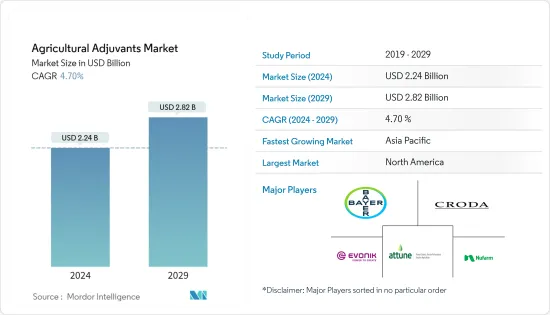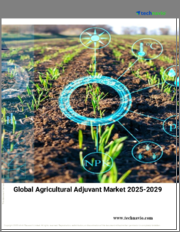
|
시장보고서
상품코드
1444077
농업용 보조제 : 시장 점유율 분석, 업계 동향과 통계, 성장 예측(2024-2029년)Agricultural Adjuvants - Market Share Analysis, Industry Trends & Statistics, Growth Forecasts (2024 - 2029) |
||||||
농업용 보조제 시장 규모는 2024년에 22억 4,000만 달러로 추정되며, 2029년까지 28억 2,000만 달러에 달할 것으로 예측되고 있으며, 예측 기간(2024-2029년) 중 4.70%의 CAGR로 성장합니다.

주요 하이라이트
- 선진국의 농업 경영에서 지속가능한 해충 관리에 대한 요구가 증가함에 따라 농업용 보조제 시장은 최근 수년간 크게 성장했습니다. 또한 세계 식량 수요를 충족시키기 위해 농업 생산성을 향상시킬 필요가 있으므로 작물 보호 화학 물질의 사용이 증가하고 있으며, 이는 농업용 보조제 시장을 주도하고 있습니다. 다양한 기후 조건에서 작물 보호 화학물질의 효과를 개선하는 것이 점점 더 중요해지고 있으며, 이에 사용되는 보조제에 대한 혁신의 필요성이 증가하고 있습니다.
- 전 세계에서 북미, 유럽, 아시아태평양을 포함한 일부 지역에서는 유전자 변형 작물의 노출 및 적용에 대해 엄격한 규제를 부과하고 있습니다. 이 지역의 GMO 작물 생산량이 적다는 것은 농업에서 보조제의 편리한 사용에 기여하는 중요한 요소입니다. GMO 작물이 대규모로 채택되면 보조제 사용은 감소했을 것입니다. GMO 작물을 재배하는 농가는 화학 약품을 사용해야 하는 문제를 해결하기 위해 유전자 변형 제초제 내성 종자를 선택하여 보조제의 필요성을 없앨 수 있습니다. 따라서 이들 지역의 GMO 작물 생산에 대한 엄격한 규제는 보조제의 성장에 크게 기여하고 있습니다.
- 또한 친환경 농업용 보조제에 대한 소비자의 선호도 증가와 생물 유래 제품의 보조제 사용 증가 등의 요인이 시장 성장에 기여하고 있습니다.
농업용 보조제 시장 동향
식량 수요 증가와 경작지 감소가 시장 견인
세계 인구는 기하급수적으로 증가하고 있습니다. 매일 20만 명에 가까운 사람들이 세계 식량 수요에 합류하고 있습니다. 미국의 인구 분류에 따르면 세계 인구는 지난 100년 동안 거의 4배로 증가하여 2050년까지 92억 명에 달할 것으로 예측됩니다. 따라서 증가하는 인구에 대한 식량 공급은 전 세계에서 위협이 되고 있습니다.
또한 지난 40년 동안 세계는 침식과 오염으로 인해 경작 가능한 토지의 대부분을 잃었고, 이는 세계 식량 수요에 비참한 결과를 초래할 수 있습니다. 지속적인 경작지 경작과 다량의 비료 사용으로 인해 전 세계에서 토양이 악화되고 있습니다. 침식은 토양이 형성되는 속도보다 최대 100배 빠른 속도로 일어납니다. 생태계의 변화를 방해하지 않고 표토 2.5cm가 형성되기까지 약 500년이 걸립니다.
또한 다양한 작물 해충으로 인해 매년 전 세계 작물 손실의 10-16%가 발생합니다. 따라서 작물 보호는 세계 식량 수요를 충족시키기 위해 농가가 채택하는 중요한 전략입니다. 농약과 함께 작물에 보조제를 사용하는 것은 세계 식량 생산을 증가시키기 위해 입증된 기술입니다. 세계은행이 발행한 데이터베이스에 따르면 전 세계 1인당 경작지 면적은 2017년 0.19헥타르에서 2020년 0.18헥타르로 감소했습니다. 따라서 전 세계 농가는 각국 정부로부터 보조제의 현명한 사용에 대한 지원을 받고 있습니다.
북미 시장 독식
북미는 농업용 보조제 시장 점유율의 대부분을 차지하고 있습니다. 첨단 작물 보호 기술의 가장 큰 시장 중 하나입니다. 옥수수, 콩 등 농작물 재배 면적이 넓으면 농약을 많이 소비하기 때문에 보조제 사용량이 많아집니다. 또한 작물 보호의 과학적 관행에 대한 인식이 높아짐에 따라 농가 차원에서도 보조제 사용률이 높아집니다.
이 지역의 주요 점유율은 인구의 급속한 증가, 경작 가능한 토지의 지속적인 감소, 표준 품질의 식품에 대한 수요 증가와 같은 중요한 요인에 기인하는 것으로 간주됩니다. 또한 농업 노동력 부족, 농업 관행의 변화, 농업이 환경에 미치는 영향에 대한 인식 증가, 지속가능한 생산 시스템에 대한 관심 증가와 같은 요인이 북미 시장의 성장을 더욱 지원할 것으로 예상됩니다.
또한 개선되고 효율적인 보조제 솔루션에 대한 지속적인 연구개발 활동은 시장의 성장 범위를 확대할 것으로 예상됩니다. 지속가능한 농업 관행을 위해 채택된 정부 정책은 보조제 소비를 지원하고 있으며, 이는 이 지역에서 조사 대상 시장의 성장을 가속하는 또 다른 중요한 요인으로 작용하고 있습니다.
농업용 보조제 산업 개요
농업용 보조제 산업 개요농업용 보조제 시장은 통합되어 있으며, 현지 기업이 가장 큰 점유율을 차지하고 있습니다. 시장의 주요 기업은 더 넓은 소비자층을 수용하고 시장 입지를 확대하기 위해 신제품 출시에 주력하고 있습니다. 저렴하고 효과적인 제품의 연구개발에 대한 투자는 시장 리더들이 채택하는 또 다른 전략입니다. 시장의 주요 기업으로는 Nufarm, Bayer Cropscience, Croda International PLC, Evonik Industries AG, Attune Agriculture 등이 있습니다.
기타 혜택
- 엑셀 형식의 시장 예측(ME) 시트
- 3개월간의 애널리스트 지원
목차
제1장 서론
- 조사의 전제조건과 시장의 정의
- 조사 범위
제2장 조사 방법
제3장 주요 요약
제4장 시장 역학
- 시장 개요
- 시장 촉진요인
- 시장 억제요인
- 업계의 매력 - Porter's Five Forces 분석
- 공급 기업의 교섭력
- 구매자의 교섭력
- 신규 진출업체의 위협
- 대체품의 위협
- 경쟁 기업간 경쟁 관계
제5장 시장 세분화
- 유형별
- 활성제
- 유용
- 용도별
- 제초제
- 살충제
- 살균제
- 기타
- 지역별
- 북미
- 미국
- 캐나다
- 멕시코
- 기타 북미
- 유럽
- 독일
- 영국
- 프랑스
- 이탈리아
- 러시아
- 기타 유럽
- 아시아태평양
- 중국
- 일본
- 인도
- 호주
- 기타 아시아태평양
- 남미
- 아르헨티나
- 브라질
- 기타 남미
- 아프리카
- 남아프리카공화국
- 기타 아프리카
- 북미
제6장 경쟁 구도
- 시장 점유율 분석
- 가장 채택되고 있는 전략
- 기업 개요
- Adjuvant Plus Inc.
- Akzonobel NV
- Brandt Consolidated Inc.
- Croda International PLC
- Evonik Industries AG
- Garrco Products Inc.
- Helena Chemical Company
- Huntsman Corp.
- Interagro(UK) Ltd
- Lamberti SPA
- Momentive Performance Materials Inc.
- Nufarm
- Solvay
- Wilbur-Ellis Company
제7장 시장 기회와 향후 동향
KSA 24.03.12The Agricultural Adjuvants Market size is estimated at USD 2.24 billion in 2024, and is expected to reach USD 2.82 billion by 2029, growing at a CAGR of 4.70% during the forecast period (2024-2029).

Key Highlights
- The agricultural adjuvants market has witnessed substantial growth in recent years owing to the growing need for sustainable pest management in agricultural operations in developed countries. Further, the need for improved agricultural productivity to meet the global food demand has imposed the increased use of crop protection chemicals, which is, in turn, driving the market for agricultural adjuvants. Increased emphasis on the improved effectiveness of crop protection chemicals in varied climatic conditions is necessitating the need for innovations in terms of the adjuvants used in them.
- Globally, several regions, including North America, Europe, and the Asia-Pacific, have imposed strict regulations on the exposure and application of genetically modified crops. The lesser production of GMO crops in this region is a crucial factor contributing to the convenient use of adjuvants in agriculture. With genetically modified crops being adopted on a large scale, the use of adjuvants would have been reduced. The farmers cultivating the GMO crops choose herbicide-resistant seeds that have been genetically modified to tackle issues for which chemicals had to be applied, thus, cutting off the requirement for adjuvants. Therefore, stringent regulations for GMO crop production in these regions have largely contributed to the growth of adjuvants.
- In addition, the factors such as growing consumer preference for environment-friendly agricultural adjuvants and increasing use of adjuvants for biological products are contributing to the market's growth.
Agricultural Adjuvants Market Trends
Growing Food Demand and Decrease in Arable Land Driving the Market
The global population is increasing exponentially. Nearly 200,000 people are getting added to the world food demand daily. According to the United States population division, the world's human population has increased nearly fourfold in the past 100 years, and it is projected to reach 9.2 billion by 2050. Thus, supplying food to the growing population has become a global threat.
Furthermore, in the past 40 years, the world has lost a major portion of its arable land due to erosion or pollution, with potentially disastrous consequences for the global demand for food. The continual plowing of fields, combined with the heavy use of fertilizers, has degraded soils worldwide. Erosion occurs at a pace of up to 100 times greater than the rate of soil formation. It takes around 500 years for just 2.5 cm of topsoil to be created amid unimpeded ecological changes.
Moreover, various crop pests cause 10-16% of global crop losses annually. So, to meet the global food demand, crop protection is the key strategy farmers adopt. The use of adjuvants alongside pesticides over crops is a proven technology for increasing global food production. As per a database published by the World Bank, the area per capita for arable land declined globally from 0.19 hectares in 2017 to 0.18 hectares in 2020. Accordingly, farmers across the globe are being supported by the respective governments for the judicious use of adjuvants.
North America Dominates the Market
North America accounts for the majority of agriculture adjuvants market share. It is one of the largest markets for advanced crop protection technologies. With large acreages under crops such as corn and soybean, which consume large quantities of crop protection chemicals, the usage of adjuvants is higher. Furthermore, the usage of adjuvants is also high at the farmer level due to greater awareness of the scientific practices of crop protection.
The major share of this region is attributed to crucial factors, such as a rapidly growing population, continuous reduction in the arable land, and increased demand for standard-quality food. Moreover, the factors such as shortages of agricultural labor, changing agricultural practices, growing recognition of the environmental impact of agriculture, and growing interest in sustainable production systems are further expected to support the market growth in North America.
In addition, ongoing research & development activities on improved and efficient adjuvant solutions are also anticipated to widen the scope for market growth. The government policies adopted for sustainable agricultural practices support the consumption of adjuvants, which is an additional key factor driving the growth of the studied market in the region.
Agricultural Adjuvants Industry Overview
The market for agricultural adjuvants is consolidated, with local players occupying the maximum share. Key players in the market are focusing on new product launches to cater to a broader consumer base and expand their market presence. Investments in research and development of cheap and effective products is another strategy adopted by market leaders. Some of the major players in the market are Nufarm, Bayer Cropscience, Croda International PLC, Evonik Industries AG, and Attune Agriculture.
Additional Benefits:
- The market estimate (ME) sheet in Excel format
- 3 months of analyst support
TABLE OF CONTENTS
1 INTRODUCTION
- 1.1 Study Assumptions & Market Definition
- 1.2 Scope Of The Study
2 RESEARCH METHODOLOGY
3 EXECUTIVE SUMMARY
4 MARKET DYNAMICS
- 4.1 Market Overview
- 4.2 Market Drivers
- 4.3 Market Restraints
- 4.4 Industry Attractiveness - Porter's Five Forces Analysis
- 4.4.1 Bargaining Power of Suppliers
- 4.4.2 Bargaining Power of Buyers
- 4.4.3 Threat of New Entrants
- 4.4.4 Threat of Substitute Products
- 4.4.5 Competitive Rivalry
5 MARKET SEGMENTATION
- 5.1 By Type
- 5.1.1 Activator Adjuvants
- 5.1.1.1 Surfactants
- 5.1.1.2 Oil Adjuvants
- 5.1.2 Utility Adjuvants
- 5.1.1 Activator Adjuvants
- 5.2 By Application
- 5.2.1 Herbicide Adjuvants
- 5.2.2 Insecticide Adjuvants
- 5.2.3 Fungicide Adjuvants
- 5.2.4 Other Applications
- 5.3 By Geography
- 5.3.1 North America
- 5.3.1.1 United States
- 5.3.1.2 Canada
- 5.3.1.3 Mexico
- 5.3.1.4 Rest of North America
- 5.3.2 Europe
- 5.3.2.1 Germany
- 5.3.2.2 United Kingdom
- 5.3.2.3 France
- 5.3.2.4 Italy
- 5.3.2.5 Russia
- 5.3.2.6 Rest of Europe
- 5.3.3 Asia-Pacific
- 5.3.3.1 China
- 5.3.3.2 Japan
- 5.3.3.3 India
- 5.3.3.4 Australia
- 5.3.3.5 Rest of Asia-Pacific
- 5.3.4 South America
- 5.3.4.1 Argentina
- 5.3.4.2 Brazil
- 5.3.4.3 Rest of South America
- 5.3.5 Africa
- 5.3.5.1 South Africa
- 5.3.5.2 Rest of Africa
- 5.3.1 North America
6 COMPETITIVE LANDSCAPE
- 6.1 Market Share Analysis
- 6.2 Most Adopted Strategies
- 6.3 Company Profiles
- 6.3.1 Adjuvant Plus Inc.
- 6.3.2 Akzonobel NV
- 6.3.3 Brandt Consolidated Inc.
- 6.3.4 Croda International PLC
- 6.3.5 Evonik Industries AG
- 6.3.6 Garrco Products Inc.
- 6.3.7 Helena Chemical Company
- 6.3.8 Huntsman Corp.
- 6.3.9 Interagro (UK) Ltd
- 6.3.10 Lamberti SPA
- 6.3.11 Momentive Performance Materials Inc.
- 6.3.12 Nufarm
- 6.3.13 Solvay
- 6.3.14 Wilbur-Ellis Company



















